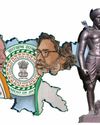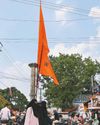Breaking the Dahi Handi may be a prized tradition, but the 'sport' has ruined many lives.

Every year the mill district of Mumbai adds more swanky glass buildings, more traffic, more people. Each new, shiny apartment squeezes out an old chawl, making the lives of its dwellers that much smaller, less important and more sombre. One such creaking sprawl in the heart of Parel is Vani chawl. Displayed prominently is a notice warning the building is unsafe. A dark wooden stairway—a couple of missing steps are supported by bamboos—leads to the one-room second-floor house of Dayanand Bhadvankar, which is home to his family of five. Dayanand hasn’t stepped out of this room for six years—he has been in bed with a broken spine, a result of his heroics in the dangerous Dahi Handi festival during Janmashtami.
The Parel-Dadar area, dotted with many chawls like Vani, is a hub of public celebrations such as Dahi Handi and Ganesh Chaturthi. Every year on Janmashtami (birthday of the Hindu god Krishna), public hospitals are on high alert to receive the ‘govindas’ injured while participating in human pyramids to break pots filled with curd hanging in the air. And yet, a recent Supreme Court verdict setting the maximum legal height of the pyramids at 20 feet and the minimum age of participants at 18 has outraged the Shiv Sena, Raj Thackeray’s MNS and the organising groups popularly called mandals, who say the courts can’t curb their religious enthusiasm.
Many govindas, however, who risk their lives for upholding traditions and culture, feel secretly relieved due to the court’s order, for they know the horrors of life after a Dahi Handi accident. “Mine was the first accident in 60 years for our mandal. I was in coma for 20-25 days. Initially, the mandal, family and friends came to my aid, but it didn’t last and I had no insurance,” Dayanand, now 32, recalls.
This story is from the September 5, 2016 edition of Outlook.
Start your 7-day Magzter GOLD free trial to access thousands of curated premium stories, and 9,000+ magazines and newspapers.
Already a subscriber ? Sign In
This story is from the September 5, 2016 edition of Outlook.
Start your 7-day Magzter GOLD free trial to access thousands of curated premium stories, and 9,000+ magazines and newspapers.
Already a subscriber? Sign In

Trump's White House 'Waapsi'
Donald Trump's victory in the US presidential election may very well mean an end to democracy in the near future

IMT Ghaziabad hosted its Annual Convocation Ceremony for the Class of 2024
Shri Suresh Narayanan, Chairman Managing Director of Nestlé India Limited, congratulated and motivated graduates at IMT Ghaziabad's Convocation 2024

Identity and 'Infiltrators'
The Jharkhand Assembly election has emerged as a high-stakes political contest, with the battle for power intensifying between key players in the state.

Beyond Deadlines
Bibek Debroy could engage with even those who were not aligned with his politics or economics

Portraying Absence
Exhibits at a group art show in Kolkata examine existence in the absence

Of Rivers, Jungles and Mountains
In Adivasi poetry, everything breathes, everything is alive and nothing is inferior to humans

Hemant Versus Himanta
Himanta Biswa Sarma brings his hate bandwagon to Jharkhand to rattle Hemant Soren’s tribal identity politics

A Smouldering Wasteland
As Jharkhand goes to the polls, people living in and around Jharia coalfield have just one request for the administration—a life free from smoke, fear and danger for their children

Search for a Narrative
By demanding a separate Sarna Code for the tribals, Hemant Soren has offered the larger issue of tribal identity before the voters

The Historic Bonhomie
While the BJP Is trying to invoke the trope of Bangladeshi infiltrators”, the ground reality paints a different picture pertaining to the historical significance of Muslim-Adivasi camaraderie